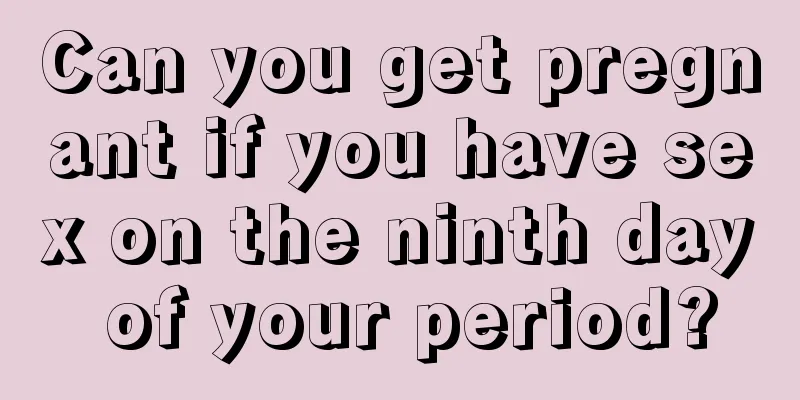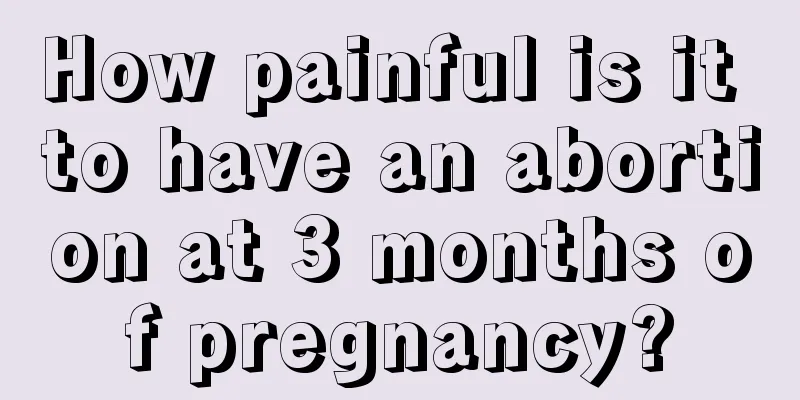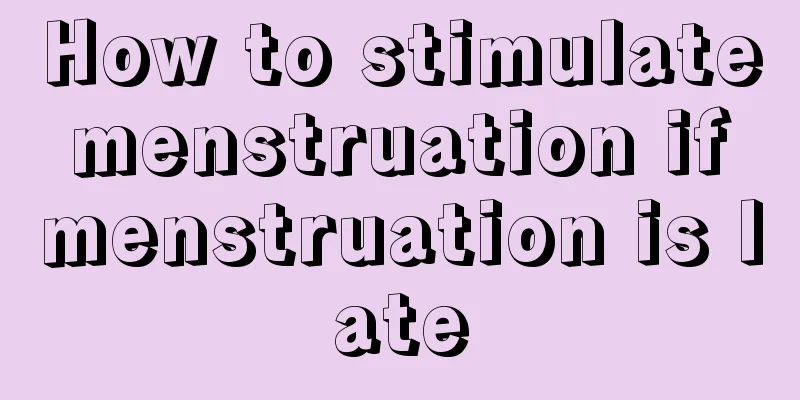Can you get pregnant if you have sex on the ninth day of your period?

|
In this case, there is a possibility of pregnancy. The time of ovulation every month is not fixed, and it does not mean that ovulation will occur on that day. If you want to know whether you are pregnant, you can use an early pregnancy test paper to check about 15 days after sexual intercourse, or see a doctor to check the blood HCG. To understand this, you first need to understand the menstrual cycle. "Menstrual" cycle time Menstruation refers to regular vaginal bleeding in women during the growth period. It is caused by the shedding of the endometrium that proliferates in preparation for pregnancy during a menstrual cycle because of the lack of pregnancy. People often call it the "menstrual" cycle because bleeding is a more obvious external and visible phenomenon. However, the key to the menstrual cycle is essentially the growth, maturity and ovulation of the ovarian oocyte; what drives this process is the regular changes of a series of hormones in the endocrine axis of the body's hypothalamus-pituitary gland, pituitary gland, and ovary, the most important of which are pituitary LH luteinizing hormone and FSH egg stimulating hormone. In other words, a menstrual cycle essentially includes the following three key changes: The "menstrual period" indicates the changes in the uterine wall. One cycle can be divided into the physiological period, the proliferative period and the metabolic period. Based on the egg development and ovulation period, it can be divided into the follicular phase before ovulation, the ovulation phase and the mid-to-late ovulation phase; Marked by the metabolism of pituitary growth hormone, it can be divided into the follicular phase and the ovarian phase. Length of menstrual cycle Generally, a menstrual cycle is about 28 days, the menstrual period is 7 days, and the interval from menstruation to ovulation is 5 days - that is, the follicular phase is 12 days, the ovulation period is 2 to 3 days, and the ovulation period to the next menarche is 13 days. It can be seen from this that the follicular phase, which is divided by the growth and development of the egg and the changes in pituitary hormone, includes the physiological phase and proliferative phase of the physiological cycle, which is divided by the "menstrual period". The above time distribution of each stage of the menstrual cycle is only a general "theoretical situation". In fact, the length of the menstrual cycle varies greatly. Generally speaking, it can be divided into three types: short cycle time, basic cycle time and long cycle time. As can be seen from the chart, the ovulation period (2-3 days) and the 14-day follicular phase (12-16 days) are relatively fixed, and the biggest change affecting the length of the cycle is the follicular phase, which has a variability range of 5-20 days. However, the length of each individual's cycle is generally regular and relatively fixed. However, it is not a big deal, because due to the stimulation of various factors, a certain cycle may become different from another cycle at any time. Pregnant Any woman of childbearing age who has an active sexual life has the potential to get pregnant during any menstrual cycle. The beginning and end of pregnancy are marked by the fusion of the egg cell and the male sperm to form a sperm-egg combination. Since the egg and sperm in the woman's body have a life span of 2 to 4 days, pregnancy is likely as long as you have sex 3 to 5 days before and after ovulation, a total of 7 to 10 days. "Seven days after menstruation" is often the "safe period" when pregnancy is very easy The question of the poster is "Can I get pregnant if I have sex 7 days after my period?" In this way, if the menstrual period is 7 days, that is to say, on the 14th day of menarche, even if it is a normal cycle, it is also the ovulation period when it is easiest to get pregnant. Even if the menstrual period is over in 3 days, it is still on the 10th day of menarche, plus the 2-4 days that male sperm survives in the female body, which is the 12-14th day, which can also cover the ovulation period. Therefore, if the end of the menstrual period is used as an indicator, 7 days later is usually the "safe period" when it is easy to get pregnant. If it is a short cycle, the follicular phase can only be 5 days, calculated based on the menstrual period of 3 to 7 days, plus the 2 to 4 days of sperm survival, then there is no so-called "dangerous period" after the menstrual period. Even if you have sex during your menstrual period, there is still a possibility of pregnancy. Of course, for long cycles, the follicular phase can be as close as 20 days, and 7 days after the menstrual period is over may be "safe". The problem is, as the answerer just said, the LH and FSH that stimulate ovulation are affected by many factors. Even for women with regular normal and long cycles, a cycle may become a short cycle at any time. Therefore, it is not necessary to say that the 7th day after the end of the menstrual period is generally in the "safe period". Even if you start calculating from the date of menarche, on the seventh day, during the so-called "safe period", it is essentially possible to get pregnant. |
<<: Symptoms of fetal hypoxia at 23 weeks of pregnancy
>>: Is it OK for pregnant women to drink coffee occasionally?
Recommend
Why do girls often have stomachaches?
Girls should be familiar with the feeling of stom...
Can I take cold medicine when I have my period?
Many women do not pay too much attention to takin...
What is the difference between body cold and uterine cold?
For women, body coldness can cause cold hands and...
Picture of black blood in early pregnancy
The first three months of pregnancy are a more im...
What to do if pregnant women have high white blood cell count
For female friends, pregnancy is a necessary stag...
What does a woman's body hair indicate?
Thick body hair is a sign of a strong man, but if...
Does a woman's oral cavity hurt?
Everyone knows that it is easy for women to get g...
The role and efficacy of DHA for pregnant women
During pregnancy, pregnant mothers are always thi...
How to get rid of lice on the head? Why do lice appear? What is the difference between lice and fleas?
Lice are parasites that often live on animal fur ...
White discharge from nipples
The breasts of women are a very important part of...
Is it better to go to a hospital or a beauty salon to get your ears pierced? Which department should I go to when getting my ears pierced?
In life, many girls will pierce their ears to loo...
Introduction to weight loss methods for middle-aged women
Losing weight for middle-aged women is a new tren...
Does constipation cause delayed menstruation?
Everyone's physical condition is different, s...
Is it okay to wear a condom during menstruation?
Proper sex life is beneficial for both men and wo...
Will pregnant women have miscarriage if they drink mung bean soup?
When a family is about to usher in the birth of a...









